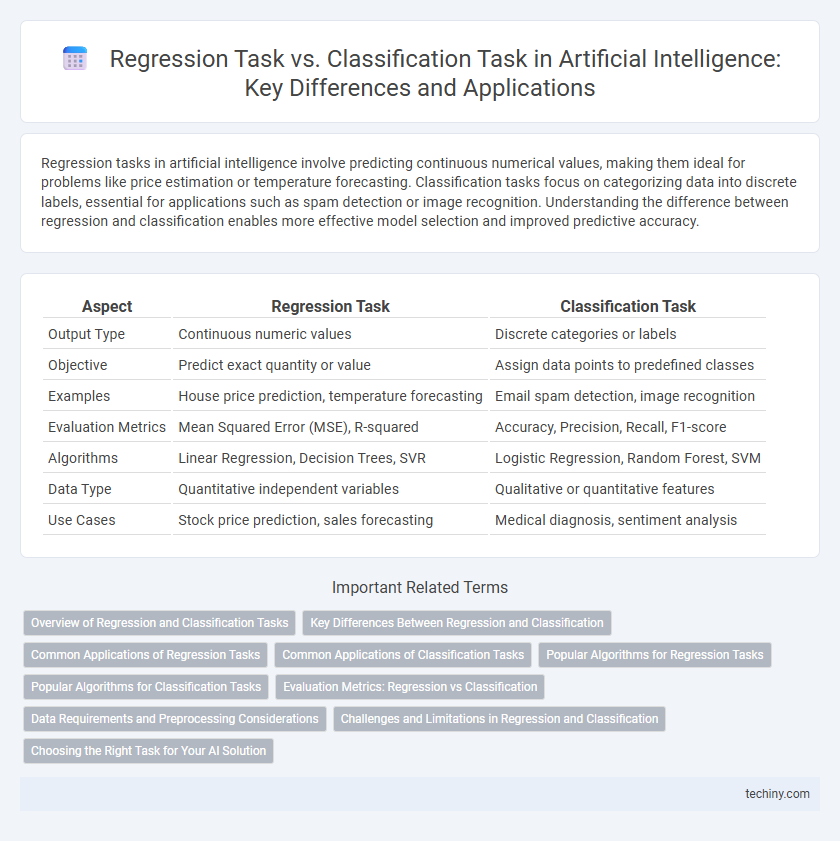Regression tasks in artificial intelligence involve predicting continuous numerical values, making them ideal for problems like price estimation or temperature forecasting. Classification tasks focus on categorizing data into discrete labels, essential for applications such as spam detection or image recognition. Understanding the difference between regression and classification enables more effective model selection and improved predictive accuracy.
Table of Comparison
| Aspect | Regression Task | Classification Task |
|---|---|---|
| Output Type | Continuous numeric values | Discrete categories or labels |
| Objective | Predict exact quantity or value | Assign data points to predefined classes |
| Examples | House price prediction, temperature forecasting | Email spam detection, image recognition |
| Evaluation Metrics | Mean Squared Error (MSE), R-squared | Accuracy, Precision, Recall, F1-score |
| Algorithms | Linear Regression, Decision Trees, SVR | Logistic Regression, Random Forest, SVM |
| Data Type | Quantitative independent variables | Qualitative or quantitative features |
| Use Cases | Stock price prediction, sales forecasting | Medical diagnosis, sentiment analysis |
Overview of Regression and Classification Tasks
Regression tasks in artificial intelligence involve predicting continuous numerical values based on input features, commonly applied in forecasting and trend analysis. Classification tasks focus on assigning input data to predefined categories or classes, widely used in image recognition and spam detection. Both tasks utilize supervised learning algorithms but differ fundamentally in output type--regression outputs quantitative predictions, while classification outputs discrete labels.
Key Differences Between Regression and Classification
Regression tasks predict continuous numerical values based on input features, making them ideal for scenarios like forecasting prices or temperature. Classification tasks categorize input data into discrete classes or labels, such as identifying emails as spam or non-spam. Key differences include output type--continuous for regression versus categorical for classification--and evaluation metrics like mean squared error for regression and accuracy or F1-score for classification.
Common Applications of Regression Tasks
Regression tasks in artificial intelligence predict continuous numerical outcomes, making them essential for applications like stock price forecasting, real estate value estimation, and demand prediction in supply chain management. These tasks leverage historical data to model relationships between variables, enabling precise quantitative predictions. Such applications drive decision-making processes across finance, economics, and resource allocation industries.
Common Applications of Classification Tasks
Classification tasks in artificial intelligence are extensively applied in email spam detection, medical diagnosis, and sentiment analysis, where data points are assigned discrete labels. These tasks enable the identification of fraud in financial transactions by categorizing behaviors as legitimate or suspicious. Image recognition in self-driving cars relies heavily on classification to distinguish between pedestrians, vehicles, and obstacles accurately.
Popular Algorithms for Regression Tasks
Popular algorithms for regression tasks in artificial intelligence include Linear Regression, Support Vector Regression (SVR), and Decision Tree Regression. Linear Regression models the relationship between dependent and independent variables by fitting a linear equation, making it suitable for predicting continuous outcomes. Support Vector Regression optimizes the margin around the predicted function, while Decision Tree Regression splits the data into branches to model complex nonlinear relationships accurately.
Popular Algorithms for Classification Tasks
Popular algorithms for classification tasks in artificial intelligence include decision trees, support vector machines (SVM), k-nearest neighbors (k-NN), and neural networks. These models excel at categorizing data into discrete classes based on labeled training data, utilizing techniques such as entropy reduction, margin maximization, and instance-based learning. Ensemble methods like random forests and gradient boosting further enhance classification accuracy by combining multiple weak learners.
Evaluation Metrics: Regression vs Classification
Regression task evaluation metrics include Mean Squared Error (MSE), Root Mean Squared Error (RMSE), Mean Absolute Error (MAE), and R-squared, which measure prediction accuracy for continuous data. Classification task evaluation relies on metrics such as Accuracy, Precision, Recall, F1 Score, and Area Under the ROC Curve (AUC) to assess model performance on discrete class labels. Choosing the right metric depends on the problem type and data characteristics to ensure accurate model assessment.
Data Requirements and Preprocessing Considerations
Regression tasks require continuous numerical target variables and often demand careful handling of outliers, scaling, and normalization to improve model accuracy, while classification tasks involve categorical target variables necessitating encoding techniques like one-hot or label encoding. Data preprocessing for regression emphasizes maintaining the integrity of numerical relationships and addressing multicollinearity, whereas classification preprocessing must focus on balancing class distributions with methods such as oversampling or undersampling to prevent biased model predictions. Both tasks benefit from feature selection and dimensionality reduction, but the choice of techniques depends on whether the output variable is quantitative or qualitative.
Challenges and Limitations in Regression and Classification
Regression tasks often face challenges related to accurately modeling continuous output variables when data exhibits high variability or noise, leading to potential overfitting or underfitting issues. Classification tasks encounter limitations in handling imbalanced datasets and ambiguous class boundaries, which can reduce model precision and recall. Both approaches require careful feature selection and scalability considerations to improve generalization and computational efficiency in complex real-world scenarios.
Choosing the Right Task for Your AI Solution
Selecting the appropriate AI task hinges on the nature of the target variable: regression tasks predict continuous numerical values, ideal for forecasting stock prices or estimating housing costs, while classification tasks categorize data into discrete classes, essential for spam detection or medical diagnosis. Understanding data distribution and project goals guides the decision, ensuring model accuracy and relevance. Leveraging domain-specific datasets enhances task alignment, optimizing AI solution performance across varied applications.
Regression Task vs Classification Task Infographic

 techiny.com
techiny.com